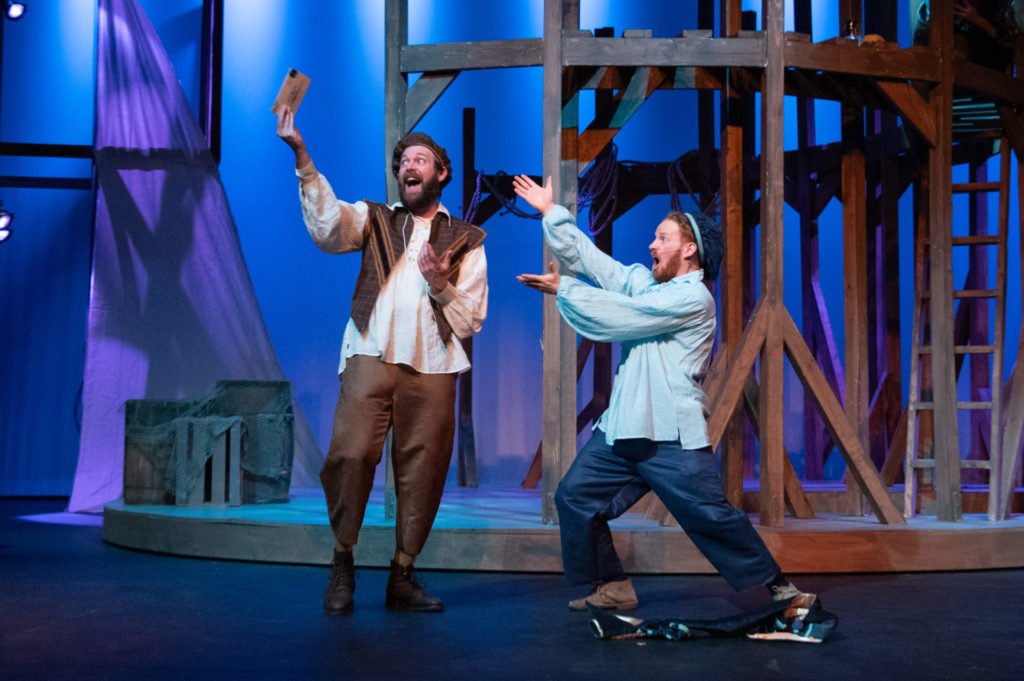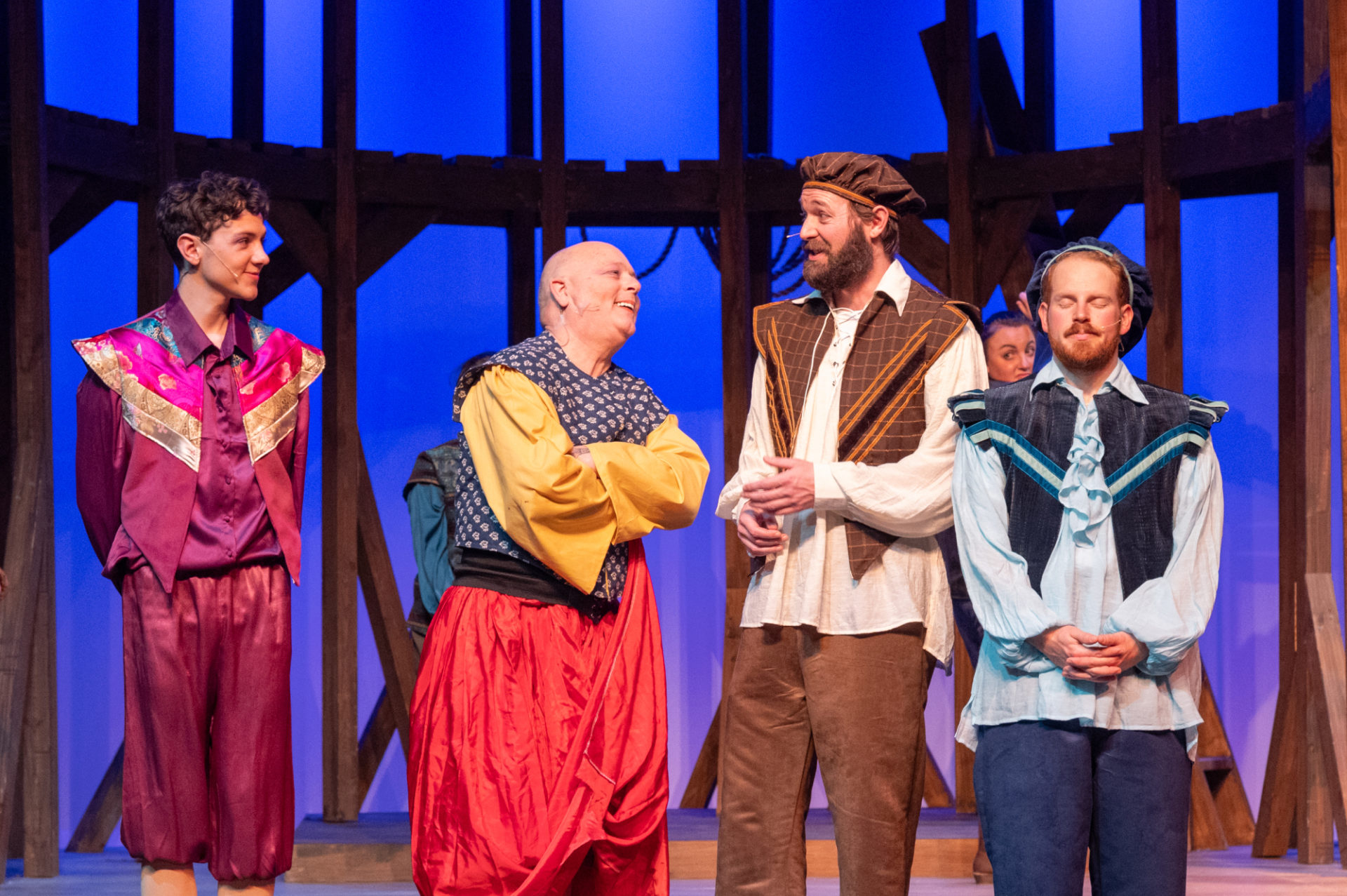The play Rosencrantz and Guildenstern are Dead, written by Tom Stoppard, takes the key moments of Shakespeare’s Hamlet and tells it from a different perspective, of the smaller characters Rosencrantz and Guildenstern. Though perhaps it’s more accurate to say that Stoppard’s play tells its own story, not just a different perspective of Hamlet. I recently saw the production at Parkland College’s Harold & Jean Miner Theatre, where it is directed by Amy Penne and continues through this weekend.
Today, every story seems to be connected to another in some sort of shared universe. To have a tale that doesn’t rely on having seen previous entries to understand the plot, would be refreshing if not for the lack of repetitious connection between the two plays that makes it almost a requirement to know more about Hamlet than the basics. Those basics: A prince’s uncle kills his brother and usurps the throne from the prince (Hamlet). The one killed comes back as a ghost to impart knowledge onto the Hamlet. The uncle banishes his nephew, the prince, and sows seeds of anger into another character, who wants revenge on Hamlet for killing his father. By the end, all the major characters who were alive up until that point are now dead after a final confrontation.
Therein lies one of my biggest problems with the script of Rosencrantz and Guildenstern are Dead. While it’s kind of important to know the key plot points of Hamlet, it can also distract from the experience. If you’re looking for the connective portions where this play and Shakespeare’s meet, you’ll miss out on all the charm and subtext littered throughout, like coins scattered across the stage floor. Conversely, not knowing who characters are and their motivations can feel like you’re missing a key piece of information that is unintentionally withheld by the playwright, understood by the characters and confuses the audience in a sort of reverse dramatic irony. In this world, everyone seems to know what’s going on in their lives — everybody, except Rosencrantz and Guildenstern.
The actors playing Rosencrantz and Guildenstern — Douglas Macolm and Anthony DeGregorio, respectively — apparently had learned their lines quickly. According to a crew member in a behind the scenes question and answer session with the cast and crew after the show, Malcolm and DeGregorio were practicing without a script as soon as the second day of rehearsal. This dedication to the craft shows through their character’s overt actions. One that immediately pops into mind is when Rosencrantz walks like an Egyptian to exit the stage house right. It’s a nice little bit of presumed improvisation that adds to the tone.

The comedic timing in particular is on par with Shakespeare and just as confusing for the modern day theatergoer. To say Stoppard pulls out all the stops is both accurate and just a glimpse into what this play is about — a philosophical romp into the ideas of fate and economic theories that, while anachronistic, plays into the story’s setting.
The play begins in medias res as the main duo are flipping coins to see how long it’ll take to get tails. It’s a bit unclear why they started or what the purpose is from within the context of the story, but that is very much by design. Just like the play’s humor, the amount of times someone tells a joke is linked thematically to the story’s motifs and other literary qualities.
Where Shakespeare is arguably better performed than read, Rosencrantz and Guildenstern are Dead is almost the opposite. There were many times where the play makes it hard to understand what’s going on. For a 21st century audience, it can be a daunting task to have that much abstract thought with little physicality.
This is all to say that Rosencrantz and Guildenstern are Dead is anything but an easy play to read alone or watch performed live and understand everything your first time through. The actors need to be quick on their feet and have the timing between lines of dialogue be just right to enact the desired effect. If a line is meant to be said quickly after another, having a pause adds an unnecessary layer of faux complexity. The context matters in that way. It’s the difference between a joke landing for the right reason and humor that, while still sticking its descent, does so accidentally.
Despite a lot of the play’s plot going over my head, the audience and the interactions with the cast were a delight. They broke the fourth wall, but it was done early enough to set it up as an element of the story rather than feeling like an easy joke.
The actors playing Rosencrantz and Guildenstern have a Pinky and the Brain dynamic. As Guildenstern, Anthony DeGregorio performs his role in the same way the more intelligent of the two rodents acts smart, but is in over his head without realizing. Rosencrantz is the bumbling foil to Guildenstern’s stoic personality. That blend of silliness matched together with serious literary techniques make this a fun play, but an even better one after watching and thinking about it more after it ends.
The wackiness and whimsy of the actors, couple with the audience’s laughter in response, breathed life into this production. That is the power of live theater, and everyone involved in the show used that to their advantage.
Rosencrantz and Guildenstern are Dead
Parkland College Theatre
2400 W Bradley Ave
Champaign
F + Sa Feb 23rd + 24th, 7:30 p.m.
Su Feb 25th, 3 p.m.
$20








